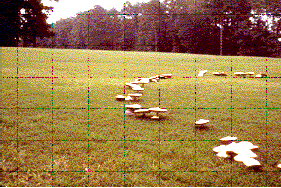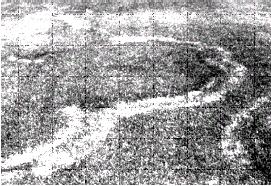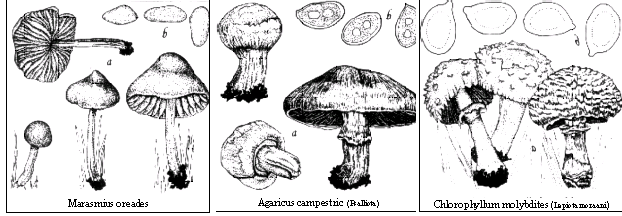Reports on Plant Diseases |
RPD No. 403 - Fairy Rings, Mushrooms, and Puffballs
|
November 1998
|
[ Symptoms ] [ Cause ][
Disease Cycle ] [ Control ]
|

Figure 1. Mushrooms
in a fairy ring.
|
Symptoms
Fairy rings can appear in any turf-grasses during the spring and early
summer as circles, arcs, or ribbons of darker green, fast growing grass.
A ring of thin, dormant, or dead grass may sometimes develop both inside
and outside this circle. Occasionally, a second zone of stimulated grass
occurs inside the zone of dead grass (Figure 2). During dry weather, especially
in the late summer and fall, the outer ring of lush grass may be missing.
Fairy rings vary from a few inches to 50 feet or more in diameter, but
most are 2 to 15 feet across. In mild weather, after rains or heavy sprinkling,
large numbers of mushrooms or puffballs (the fruiting bodies of the fairy
ring fungi) may suddenly pop up in the outer circle of lush grass (Figure
1). Commonly, several distinct rings or arcs develop in the same general
area. Where the rings meet, fungus activity ceases, and the rings take
on a scalloped effect (Figure 3).
Generally, fairy rings are first seen as a cluster of mushrooms or as
a tuft of stimulated turf. The rings may grow outwardly for years or be
disrupted when intercepted by a driveway, building foundation, or flower
bed. Some rings disappear unexpectedly for a year or more and then reappear,
usually a foot or more, larger in diameter.
|
Cause
The disease is caused by any one of about 50 soil-inhabiting fungi (mushrooms
[toadstools] and puffballs), the most common being the small, tan fairy ring
fungus, Marasmius oreades. Agaricus (Psalliota) campestris
or A. bisporus, the cultivated mushroom, will also cause fairy
rings. Both of these fungi are nonpoisonous, however, do not eat any
mushrooms growing in turf areas without first having them identified by a competent
authority. The immature stages of Agaricus are indistinguishable
from the large, white, poisonous Chlorophyllum molybdites (Leptiota morgani);
see Figure 4. Only at maturity can these two mushrooms be identified accurately.
Even when identified as edible, a mushroom may not be entirely safe. Some individuals
may have allergic reactions, while others can become ill if wine or other alcoholic
drinks are also consumed. Since children are the largest group of fatalities
associated with mushroom poisoning, it is best to dispose of the mushrooms as
they appear.
Back to Top
|
Nutrients for these fungi come from the breakdown of organic matter.
Infection often begins where large roots or lumber are buried in the soil.
Growth usually starts with a germinating fungal spore or with pieces of
mycelium at a central point and continues radially in all directions.
Each year the rings may enlarge from 5 inches to 2 feet or more. The fungus
grows throughout the soil, sometimes to a depth of 8 inches or more. If
you dig deeply into the ring area with a trowel or spade, you will find
a dense, white, threadlike network of mycelium (mushroom spawn) that has
a strong musty odor.
The lush, dark green grass of the fairy ring is due to the increased
amount of nitrogen made available to the grass roots by the fungus as
it breaks down organic matter in the thatch and soil. The ring of brown,
dormant or dead grass is caused by the dense, subsurface layer of mushroom
spawn that impedes water movement into the soil, depletes nutrients essential
for plant growth, and may produce toxic levels of ammonia or hydrogen
cyanide, as is suspected of M. oreades. The
grass in this area can become so weakened that it succumbs to environmental
stresses or the grass roots are killed by the fungus as other disease
organisms. Invasion by weeds soon follows. As the fungus grows outward
radially, the older spawn in the interior of the ring dies, releasing
nitrogen and other nutrients for use by the grass plants, initiating the
possible formation of the inner green ring of stimulated grass (Figures
2 and 3). If this lush growth persists into the autumn, the chances of
Microdochium nivale (pink snow mold) infection increase.
Fairy rings are usually most severe in light-textured, low-fertility soils
that are low in moisture. The rings are more common and damaging on lightly
watered and fertilized golf fairways and lawns than on well-irrigated
and fertilized golf greens, tees, and lawns. Turf with a thick thatch
and growing in a sandy soil is very vulnerable to damage, especially in
drier regions.
|

Figure
2. Top view and cross section of fairy ring with rings of stimulated
grass with mushrooms, weak or dead grass, mycelium of fairy ring fungus
in soil, and central area invaded by weeds (drawing: L Gray).
|
Back to
Top
Controlling fairy rings is not easy because the soil becomes almost impervious
to water. Before planting a new turf area, remove tree stumps and large roots,
construction lumber, and other large pieces of organic matter from which these
fungi obtain nutrients. Keep the new planting well fertilized and watered to
a depth of 6 inches or more. Shallow watering encourages the germination of
many fairy ring fungi. In established turf area, fairy rings can be effectively
controlled laborious and time-consuming methods: suppression, eradication, and
antagonism.
A. Suppression. To suppress ring formation, water the turf thoroughly
and fertilize well to enhance the growth of grass within and around rings to
a level close to that of the lush ring of grass.
- The symptoms are easily disguised by pumping large quantities of water
into the soil, 10 to 24 inches deep, at one-foot intervals, for a distance
of 18 to 24 inches on either side of the stimulated zone of dark green grass.
Maintain the soil in a near water-soaked condition for 4 to 6 weeks by watering
every 2 to 3 days. Use a tree-feeding lance or root-feeder attachment on a
garden hose. Repeat the treatment, several months to a year or more later,
when the rings begin to wilt. (This is the easiest and cheapest method of
suppression).
- Since there are fewer rings and they are much less conspicuous on adequately
watered and fertilized turf, apply nitrogen fertilizer to the turf several
times during the year. Follow local recommendations based on a soil test and
the cultivar or blend of grass being grown. Avoid excessive applications of
nitrogen and organic matter manure or mulches as they tend to stimulate the
development of fairy rings and encourage other turf diseases. Core cultivation
and use of wetting agents (surfactants) helps water to move more deeply in
infested soil.
B. Eradication. Fairy rings can be eradicated by soil fumigation or
excavation. Drenching with a fungicide has met with only moderate success.
- Fumigation. Carefully strip and dispose of the sod in an area 2
feet inside and 2 feet outside the outer green ring of grass. Be careful not
to spill any of the infested soil or sod on the healthy turf. A better but
more expensive method is to apply glyphosate (Roundup, Kleenup) to the area.
This will kill the grass in about a week with little or no chemical residue
remaining to affect the new planting, however, you will still have to dispose
of the dead turf after using glyphosate because it may still contain living
mycelium of the fairy ring fungus. Loosen the soil underneath to a depth of
6 to 9 inches with a spading fork or by rototilling, to improve the results.
Have the soil fumigated by a certified golf course superintendent or turfgrass
specialist who is licensed to handle and apply restricted use pesticides.
The soil temperature should be 60 F (16 C) or above for fumigation. The
vapors of the fumigant are kept in the soil by carefully covering the stripped
areas with a gas-proof plastic cover for 7 to 10 days depending on the fumigant
used. The plastic cover is removed after the fumigation period. After removing
the cover, the soil should be stirred and left exposed to the air for 2
weeks or until all odor of the chemical has disappeared. Fresh soil should
be added to the area as needed, followed by seeding or sodding.
- Excavation. Carefully dig out and haul away at a safe distance from
turf all infested soil in the ring (12 inches or more deep and extending 2
feet on either side of the outer stimulated zone, including all mushroom spawn)
and replace soil in the trench with fresh, clean (preferably sterilized) topsoil
that is free of fairy ring fungi. The area is then sodded or reseeded. This
method is generally impractical and too expensive in most situations.
|

Figure
3. Antagonism between fairy ring fungi. Note living grass where rings
intersect.
|
C. Antagonism. Antagonism is most effective when a turf area is
heavily infested with a number of fairy rings. The biology of these fungi,
for example, M. oreades, will ensure that two or more strains
will eliminate each other when occupying the same site. Figure 3 shows
how antagonism has stopped disease development where two fairy rings meet.
This method of control, while requiring the same initial steps that are
used for eradication, is much cheaper because the costs for chemical fumigants
and for a licensed applicator are eliminated. Also, there is no danger
of injury from contact or inhaling chemical fumes.
- After killing the infested area with glyphosate and stripping the
sod, thoroughly rototill the entire area covered by the fairy rings.
Using a rake, collect the white mycelial spawn from several rings and
blend it thoroughly. Spread the blended spawn as evenly as possible
over the exposed soil, then mix the mycelium-infested soil by multiple
cultivations with a rotary cultivator to a depth of 6 to 8 inches in
several directions to effectively mix the spawn of the fungi. Rake or
roll the soil level and fertilize.
- Wet the soil to a depth of 8 inches or more with or without adding
a wetting agent to increase water infiltration into the denser spawn
layers. Keep the soil bare for several weeks (or more), such as through
winter, then sod or reseed the area. Keep it well watered and fertilized.
|
Back to Top
MUSHROOMS AND PUFFBALLS
A large number of species of fungi that produce mushrooms (toadstools) and
puffballs feed on decaying organic matter in the soil. These fungi, including
those that produce fairy rings, are most common around dead and buried stumps,
roots, boards, or excess thatch. The spore-producing mushrooms and puffballs,
which are 1 to 12 inches in diameter, appear after heavy rains or watering.
Some mushrooms and puffballs are foul-smelling; a few are poisonous. These nuisance
fungi overwinter as mycelial spawn in the soil and in decaying organic matter.
The fruiting bodies produce large numbers of microscopic spores that are spread
by air currents, water, turfgrass equipment, and tools of all kinds.
The control for mushrooms and puffballs, where practical, is to carefully dig
up and destroy rotting stumps, roots, or other underground sources of organic
debris. If you suspect the fungi of being poisonous to children or pets, break
or mow off the fruiting bodies when first seen. Mushrooms and puffballs will
disappear naturally only when the food base in the soil is exhausted. This process
may take 10 years or more for a large stump or root.

The mention of a trade name or proprietary product does not constitute warranty
of the product and does not imply approval of this material to the exclusion
of comparable products that may be equally suitable. Always read and follow
the current package label instructions and precautions.
Back to Top
For further information concerning diseases of crucifers
and other vegetables, contact Mohammad Babadoost, Extension Specialist in Fruit
and Vegetable Diseases, Department of Crop Sciences, University of Illinois at
Urbana-Champaign. University of Illinois
Extension provides equal opportunities in programs and employment.
|



